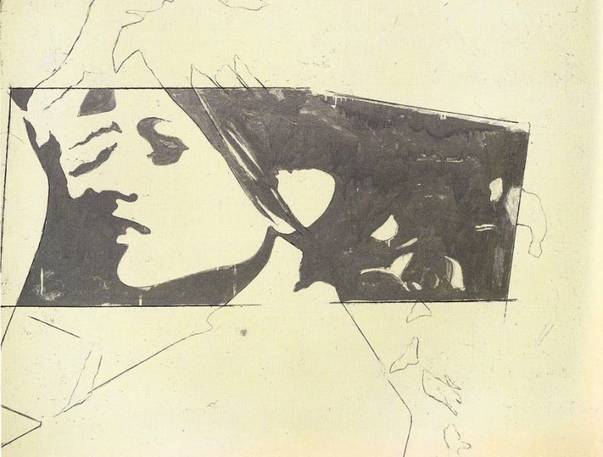


NYC's the Drawing Center [2] (35 Wooster Street ) is now hosting the show Giosetta Fioroni [3]: L'Argento, the artist’s first solo exhibition (April 5–June 2, 2013) in North America. The collection features over seventy drawings, thirty paintings, ten illustrated books, three films, and related ephemera.
Giosetta Fioroni (b. 1932, Rome, Italy) was the only female member of the Scuola di Piazza del Popolo [4], a group of artists that emerged in Rome during the 1960s around the famous Galleria La Tartaruga [5]. Fioroni had numerous solo exhibitions at La Tartaruga throughout the 1960s and 1970s and she participated in landmark group exhibitions such as Nuove tendenze in Italia at Galleria del Naviglio, Milan, Italy (1966); and Vitalità del negativo nell’arte italiana 1960/70 at Palazzo delle Esposizioni, Rome, Italy (1970-71).
Other important solo shows include Galerie Breteau, Paris, France (1963); Galleria del Naviglio, Milan, Italy (1965, 1967, 1969, 1971); Modern Art Agency, Naples, Italy (1968); Galleria Il Punto, Turin, Italy (1970); and Galleria de’ Foscherari, Bologna, Italy (1974). In 1972, a large-scale retrospective of the artist’s work was exhibited at Centro Attivitá Visive del Palazzo dei Diamanti in Ferrara, Italy.
Fioroni participated in the Venice Biennale [6] in 1956 and 1964, and she was assigned a personal room at the 1993 Venice Biennale. The artist currently lives and works in Rome, Italy. The current show presented at the Drawing center will be on view at Galleria nazionale d'arte moderna e contemporanea [7] in Rome from October 31, 2013–February 23, 2014.
Working primarily with silver enamel paint and graphite, Fioroni developed a unique aesthetic featuring figures taken from 1960s Italian cinema and magazines, as well as family photographs. Her largely female subjects are frequently caught in the act of looking and, framed with perspective lines and leftover pencil tracings, her paintings and drawings appear to chart the viewer’s imaginative and visual process as well.
Indeed, the evident drawn lines that define and frame her subjects indicate not just a sustained investment in the handmade, but also, as one critic puts it, “a fidelity to sight,” to the way in which images are transmitted and received.
Fioroni’s figures are not simply found, they are intended — reconstructed in and through the act of perception. In this way, Fioroni offers an alternative to the pervasive view of Pop art as instantiating a male dominating gaze and passive female subject. She does this, however, not by liberating female sexuality in the manner of American female Pop artists like Pauline Boty [8] and Marjorie Strider [9], but rather, by deconstructing the gaze and making observation itself her subject.
Giosetta Fioroni: L’Argento opens with Fioroni’s drawings from the late fifties featuring obscure notations alongside recognizable signs such as hearts and arrows executed in pastel and pen-andink. Immediately after completing these drawings, Fioroni simplified her aesthetic, executing a group of silver monochromes dated 1959-61 empty but for framing lines that foreshadow the work to come.
Three of these paintings frame the entrance to the Main Gallery which is hung with paintings and drawings from Fioroni’s L’Argento (silver) period (1963-1970). The Drawing Room features twenty of Fioroni’s silver landscape drawings from the early seventies whose lyrical minimalism has inspired texts by such renowned Italian thinkers as Goffredo Parise [10] (with whom Fioroni had a longstanding relationship until his death in 1986), Vittorio Gregotti [11], and Alberto Moravia. [12]Finally, three of the artist’s films are screened in The Lab [13].
The show also features drawings and illustrated books inspired by theater, literature, and fairy tales, as well as documentary material relating to early performances, and miscellaneous objects including a little theater that the artist executed in 1969. Significantly, Fioroni has argued that all of her work has its basis in theater, theater being the art form that, more than any other, unites narrative staging with the act of beholding.
In addition to the show, the Drawing Center has organized some public programs:
Wednesday, April 17th at 6:30pm Nicholas Cullinan, Curator of Modern and Contemporary Art at The Metropolitan Museum of Art [14], will discuss the vital post-World War II artistic developments and exchanges that put Italy on the international map.
Thursday, May 23rd at 6:30 pm David Forgacs, Zerilli-Marimò Chair in Contemporary Italian Studies at NYU, will speak about the fertile renaissance in Italian film in the 1960s, which boasted such directorial greats as Michelangelo Antonioni [15], Luchino Visconti [16], and Pier Paolo Pasolini [17], and the cinematic influences on Fioroni’s work.
Source URL: http://ftp.iitaly.org/magazine/focus/art-culture/article/italian-art-in-nyc-giosetta-fioroni-largento
Links
[1] http://ftp.iitaly.org/files/largento11365694297jpg
[2] http://www.drawingcenter.org
[3] http://www.drawingcenter.org/en/drawingcenter/5/exhibitions/9/upcoming/117/giosetta-fioroni/
[4] http://it.wikipedia.org/wiki/Scuola_di_Piazza_del_Popolo
[5] http://www.galleriadellatartaruga.com/new/
[6] http://www.labiennale.org/en/Home.html
[7] http://www.gnam.beniculturali.it/index.php?en/1/home
[8] http://en.wikipedia.org/wiki/Pauline_Boty
[9] http://en.wikipedia.org/wiki/Marjorie_Strider
[10] http://it.wikipedia.org/wiki/Goffredo_Parise
[11] http://en.wikipedia.org/wiki/Vittorio_Gregotti
[12] http://www.imdb.com/name/nm0603179/
[13] http://thelabgallery.com
[14] http://www.metmuseum.org
[15] http://www.imdb.com/name/nm0000774/
[16] http://www.imdb.com/name/nm0899581/?ref_=sr_1
[17] http://www.imdb.com/name/nm0001596/?ref_=sr_1